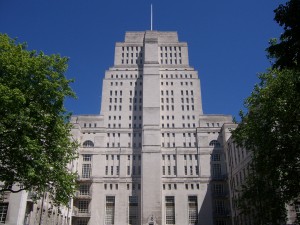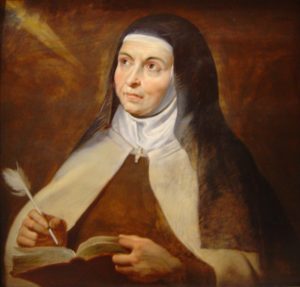IMLR Visiting Fellow, Corinna Deppner, talks about the research she undertook whilst at the IMLR
From 1 October to 30 November 2017 I was a Visiting Fellow at the Institute of Modern Languages Research (IMLR) at the University of London. The objective of my stay there was to research my postdoctoral project “Interreligious encounters in mystical worlds of experience of the early modern era. Emotion research as a passageway between literatures of the 16th and 20th centuries”. Since October 2016, I have been pursuing a project on religious encounters in mystical worlds of experience at the Institute of Romance Studies at the University of Erfurt. During my stay in London, I consulted the holdings of Senate House Library and the British Library. The Department of Latin and American Studies at Senate House Library, deserves special mention. Their collections have enabled me to deepen my research on notions of mysticism in the work of Brazilian author Clarice Lispector, whose literature is an essential primary text of my investigations, and which I am questioning regarding structural compatibility with the work of the Spanish Golden Age mystic, Teresa of Ávila. Here is a brief insight into the results of my two months of research.
The narratives of the Brazilian author Clarice Lispector (1920-1977) feature a minimalist plot and the presence of interior female perspectives. Because of their emotionally charged structures, her novels have been described as “modern-day mysticism”. Attempts at interpretation of this kind have recourse to the Spanish mysticism of the sixteenth and seventeenth centuries, the principal impetus for which is held to come from John of the Cross and Teresa of Ávila.
Teresa of Ávila (1515-1582) came from a Jewish family which underwent baptism at the time of the Inquisition and persecution, and whose members attempted to survive as conversos. It is necessary to ask by what factual and methodological approach the experiences of the culture of the Spanish Siglo de Oro – a Christian culture, yet at the same a culture shaped by the inquisition and persecution of the Jews, a culture to be seen as crucial to the work of Teresa of Ávila – can bear comparison with that of Clarice Lispector. Clarice Lispector was born in 1920 in the Ukraine. She was given the Hebrew name Chaya. In 1921 Lispector’s Jewish family, having fled the pogroms, emigrated to Brazil.
A starting point for this cross-historical overview is the assumption that the timeliness ascribed to the poetry of the mystic of the Siglo de Oro is to be traced to transformations which, on the one hand, draw their meaning from reformulations of referential Biblical texts, and on the other show themselves to be prefigurations of modern writing styles.
There are three specific connecting points which I use for the comparison of the two authors:
Mystic-religious patterns and inner exile
Linguistic-philosophical paradigm of mystical speech
Gender-specific approach resulting from a re-reading of mysticism and modernity
During my stay at the IMLR, I focused on the last aspect. It goes back on the assumption that mystic discourse provides a possibility for forms of feminine articulation located outside male ascription. In her ideas about the mystical and the hysterical, Luce Irigaray argues that the location of feminine speech is a place of speechless, unconscious corporality, which yet mirrors what is lacking. Thus, to Irigaray, hysteria and mysticism become possibilities of a feminine, non-linguistic discourse in maleness: in the “phallocentric” order which excludes her, the hysteric reflects her speechlessness in her bodily symptoms, and mysticism marks the other extreme from Descartes’ logicisation of the ego: a personal pleasure of women which occurs at the high point of their submission to the order of the Other – God – and, with the extinction of the ego, ensures a maximum ecstasy beyond all logic. Although the declared aim of Cixous and Irigaray was to overcome this feminine impotence of speech, Kathrina Reschka’s study emphasises stillness as a form of feminine literary articulation, not to be considered as impotence, but as an entry to an ineffable world. In the discourse of mysticism Reschka finds confirmation of her assumption to the extent that in Mediaeval mysticism stillness generated fullness, since it was in such stillness that the voice of God spoke to the mystic.
This positive connotation of stillness in mysticism is then the Holy Silence – as Cixous and Irigaray formulate it – to be borrowed and utilised for Lispector’s eventless literature, whose reductionist plot strains towards expression with ever new word and sentence constructions. For mystics the adequate form of expression is silence, as a reaction to the collapse of the language system, which at the same time releases a speaking or writing which continues to infinity. An enlarging interpretation of hysteria enables us to see silence as that caesura which attempts to overcome impotence of speech by the generation of ever new forms of representation.
Accordingly, the perspectives in Lispector’s writing, her dissociations, for ever breaking out in numerous directions and largely defying logical ascriptions are paired with a radical negativity which becomes manifest in descriptions and evocations and at the same time seems to be the source of her writing. Also present therefore is that very silence – the negation of speech – which is evoked as a form of literary articulation with feminine connotations, as a free, non-referential area. Thus the painful narratives of her novels amount to an abandonment of any search for identity. “Giving up is a revelation” Lispector writes at the beginning of the last chapter of The Passion according to G.H. And continues: “Finally, finally, my casing had really broken and without limit I was.”
When it comes to the relation between women’s writing and mystic writing as reflected in the representations of hysteria, a line of reference to the literature of Teresa of Ávila is Teresa’s vision of the inner castle. What is reflected there, out of a withdrawal, is comparable on the one hand – as she suggests herself – to the quality of delineation possessed by a crystal; on the other hand, used psychologically, it indicates the splitting of identity.
Teresa of Ávila described the mystic soul as “a castle, formed of a single diamond or a very transparent crystal, and containing many rooms, just as in heaven there are many mansions […] [and] in the centre, in the very midst of them all, is the principal chamber in which God and the soul hold their most secret intercourse”. In her description the soul appears separated into dwellings, into an infinite number of chambers pertaining to the architecture of heaven, as a palace, further as a palm, and particularly as a crystal. We note the search for ascriptions of the representations portrayed in this description. The change in ascriptions, which in the description of the inner castle, too, circle round a hidden reference in the manner of signifiers indicates an attempt to provide with attributes something which is, in its core, non-representable. Clarice Lispector’s narratives are not in their motifs linked to the metaphor of a building, an arrangement of rooms, a path or any other comparable reference. The unique feature of her linguistic images, upon which a presentation of non-presentation is inscribed, is the creation of crystalline structure as a linguistic architecture. In this presentation, despite the successive arrangement of events, responses to the inner life are overlaid by a breaking in of the outer world, descriptions of sense impressions encounter interlaced perception surges. These mood images alternate with depictions of relations which are not infrequently endowed with unexpected attributes. This applies to all novels in which individual facets deploy their effect like the reflections of a crystal.
Corinna Deppner, IMLR Visiting Fellow (2017/18)


